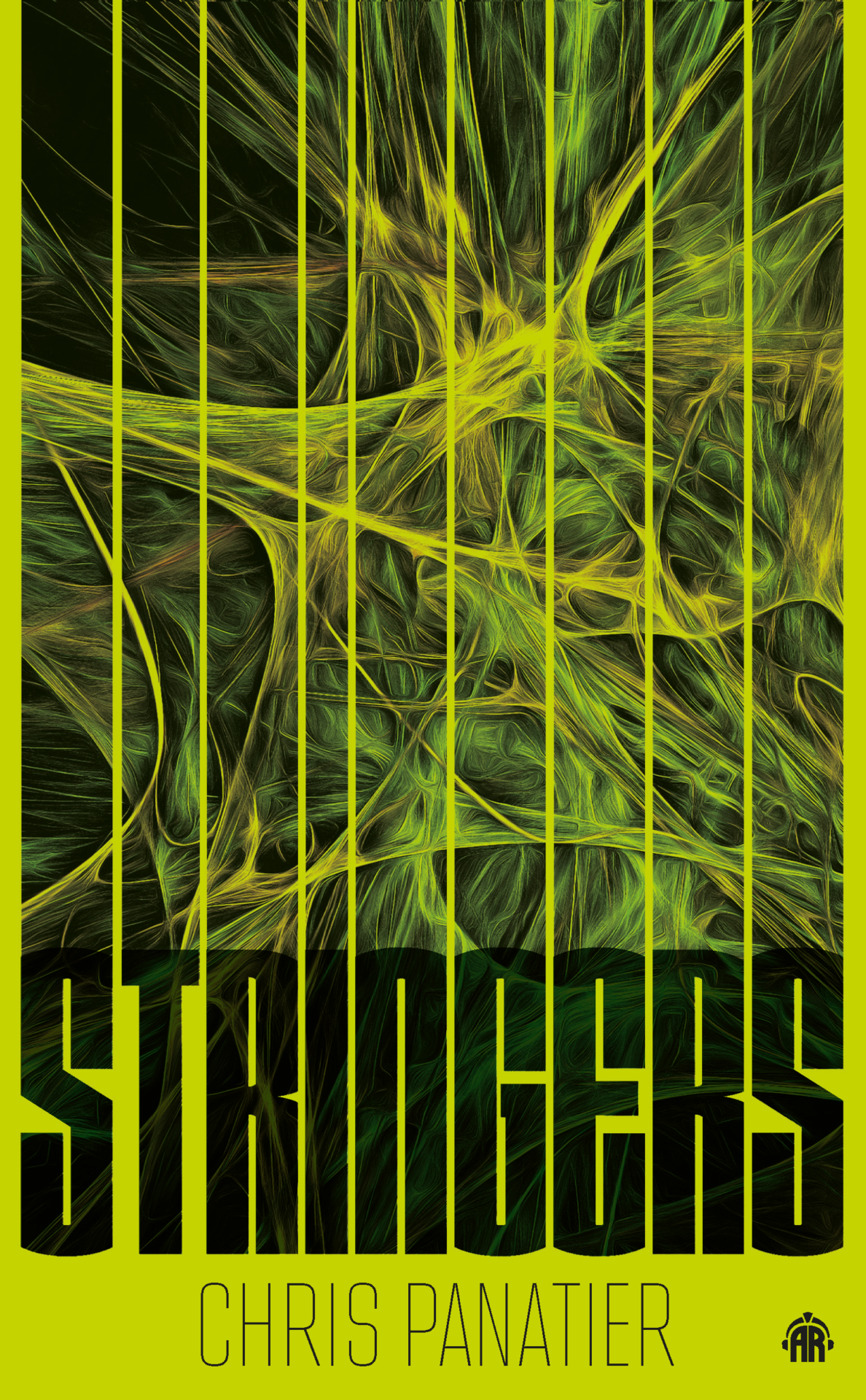
Chris Panatier is joining us today to talk about his novel, Stringers. Here’s the publisher’s description:
Knowledge can get you killed. Especially if you have no idea what it means.
Ben is not a genius, but he can spout facts about animals and wristwatches with the best of experts. He just can’t explain how he knows any of it.
He also knows about the Chime. What it is or why it’s important he couldn’t say. But this knowledge is about to get him in a whole heap of trouble.
After he and his best friend Patton are abducted by a trash-talking, flesh-construct alien bounty hunter, Ben finds out just how much he is worth… and how dangerous he can be. Hopefully Patton and a stubborn jar of pickles will be enough to help him through. Because being able to describe the mating habits of Brazilian bark lice isn’t going to save them.
What’s Chris’s favorite bit?

CHRIS PANATIER
Space is, uh, big.
This is a problem when you want to tell stories set there because distance is a real impediment to fast action. Even a light delay of a few minutes can really trip up the flow of a scene:
Captain Jax yelled into the communicator. “Are you telling me the Skryhulks of Thrull-976 have attacked the asteroid base?” She depressed the hail button and then rapped her fingers on the console. Coffee would be nice. She glanced at the coffee machine. Someone forgot to brew a fresh pot.
Ten minutes later the answer came through the communicator. “Yes!”
Jax swallowed the dregs from her mug. “Shall I dispatch a squadron of Gravjets to help?” she replied.
She poured herself another cup. Less sugar this time. After ten more minutes, the asteroid base responded, “Yes! We aahblladaaaaahbmmbtthbbhhtgbhbb…” Static. They were already dead.
Now that I read it, that’s pretty funny. But still. Light delay is real. And light travel, in galactic terms, is slower than an Andromedian glorp snail filling out tax forms. Rarely can a sci-fi space story with sprawling scope move forward without figuring a way to break some rules. Even The Expanse, which is pretty dang rigorous in terms of plausible tech, had to create a system of travel which would cross distances instantaneously.
I needed to do the same with my new novel, STRINGERS. Other than having to create a wink-wink “plausible” system, I encountered a few additional problems. The first was that I am not any type of scientist. The second was that it’s all been done before. My goal in drafting the story was to learn enough to blunt problem number one and possibly candy-coat problem two.
Wormholes, of course, are the easy answer. They’re plausible, theorized, widely discussed in the peer-reviewed literature. A little handwaving on things like size and impermanence, and bada-bing, instantaneous-ish travel! But I didn’t want to do wormholes because, well, they’re so…2021.
Science fiction is full of fascinating takes on locomotion in a vacuum. John Scalzi did skip drives, which are worm-hole-ish but different in that they punch a hole into another universe which is an almost perfect replica of the vacated universe. Charlie Jane Anders wrote about the “spaceweave” for Victories Greater Than Death, which is like linked sections of space that only smaller ships can use. Both examples are rooted in real science theory and do a good job of extrapolating to something that is useful in a story. There are also many, many examples where authors (smartly) make no attempt to explain how their FTL systems work—they just do. And that’s totally fine.
As a fan of the hard stuff (sci-fi), I wanted to start from fairly grounded ideas before I built my very fictional FTL system. I started with entangled particles. Entanglement is all about linked particles which remain so even over huge distances. Influencing one, broadly speaking, influences the other…instantly. So. I went to the place you go to learn things with absolutely no risk of any misinformation whatsoever, Youtube, and my verdict, after watching innumerable hours of physics videos, is that you can warp the concept of particle entanglement to nearly any purpose. This may or may not be scientifically accurate (okay, not).
But it doesn’t have to be exactly accurate, so long as you build credibility by acknowledging what you are doing. An important lesson I learned in creating a believable FTL system (and shattering other scientific principles) was to signal to the reader that I knew the rules before I proceeded to very publicly and deliberately break them.
For my story I wanted instantaneous travel across the entire universe—a big ask that breaks aaaaaaaaalll the rules. Conveniently, but without any plans to use it for FTL, I’d already conjured something for another part of the story called the Oblivion Fray. This substance, according to me, is the “raw material of consciousness,” and is the explanation of dark matter. Thoughts are heavy, mkay?
Once I realized I already established this fundamental, ubiquitous building block, I modified it so that it could be used for FTL. First, I made the particles of the Oblivion Fray universally entangled. In other words, every particle has the potential to act upon any other particle when triggered. Second, I made them “protoparticles” (a real, hypothesized thing) which are like little baby particles that can become a wide range of particle types when they grow up. So how does that equal instant travel?
One of my characters, Naecia HyRope, builds a machine. The machine is an extremely powerful computer, but does nothing more than aggregate and catalogue the particle data of an object—like a spaceship—so it can be reproduced elsewhere. Since the particles that will be doing all the work on the far end of the journey are these protoparticles of consciousness—Oblivion Fray—it only made sense that the actual drive part of this machine be a mind. Thus, Naecia, the machine’s architect, serves as the hub, the link between the data aggregator and the Fray. When initiated, the machine dumps the data through her mind and into the Fray. They blip out of existence (no cloning rule of physics) and are instantly reproduced by these protoparticles wherever Naecia tells the Fray to put them. In essence, the ship switches places with itself.
So that’s my FTL system: the Switch Drive. Something that borrows concepts from real science (entanglement, protoparticles, quantum computing) and pairs it with a sentient interface as a means to making it all work. My apologies to the good folks at the Jet Propulsion Laboratory.
LINKS:
BIO:
Chris Panatier lives in Dallas, Texas, with his wife, daughter, and a fluctuating herd of animals resembling dogs (one is almost certainly a goat). He writes short stories and novels, “plays” the drums, and draws album covers for metal bands. Plays himself on twitter @chrisjpanatier. Chris’s debut novel, The Phlebotomist, was published in 2020 and was on the “Recommended Reading” list for Bram Stoker Award 2020.
